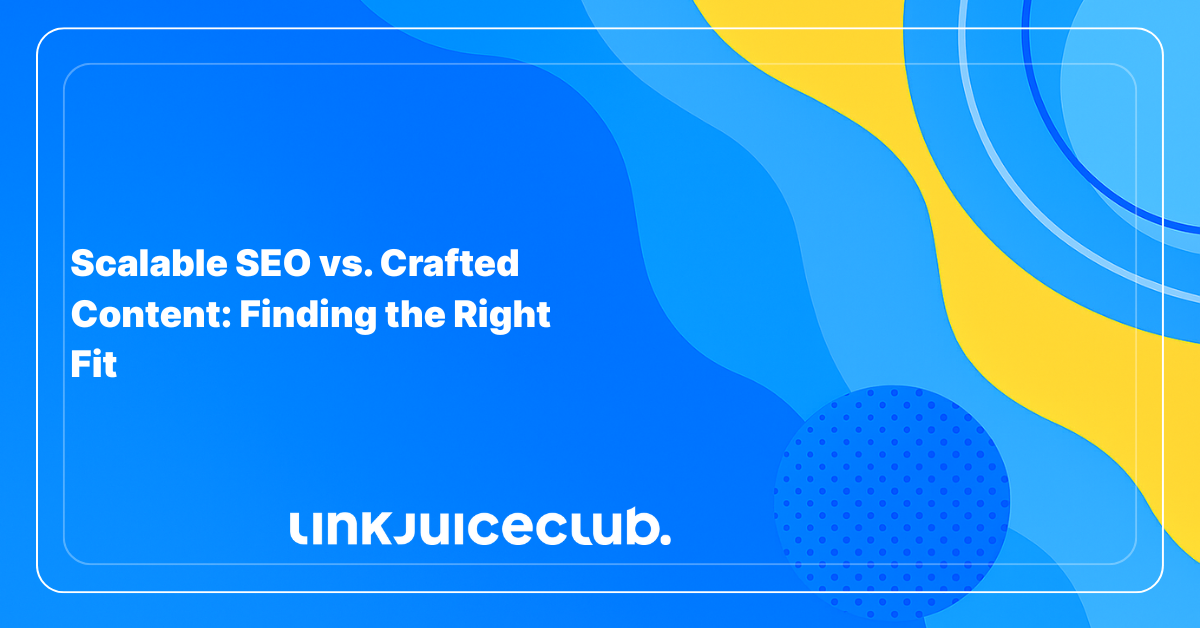
Scalable SEO vs. Crafted Content: Finding the Right Fit
Scaling visibility without compromising quality? That’s the tension at the heart of Programmatic SEO vs Manual Content. One leverages automation and data. The other bets on creativity and human insight. Which one matches your goals?
According to recent industry stats, over 70% of marketers claim programmatic SEO helps them save time and boost site traffic. The appeal is clear: build once, scale infinitely. But does fast always mean effective?
Manual content publishing champions control, originality, and editorial polish. Programmatic SEO, powered by tools like Auto Page Rank, generates thousands of SEO-friendly pages that are indexable, trackable, and tuned for long-tail discovery.
Both approaches serve a purpose. The trick lies in knowing when to scale with code and when to connect with crafted content. In this guide, we’ll break down both sides so you can decide what moves the needle for your brand.

Source: https://pixabay.com/illustrations/seo-marketing-agency-work-research-7092116/
What Is Programmatic SEO, Really?
At its core, programmatic SEO automates the creation of pages using structured data. Think: location pages, product variations, or content templates that change based on inputs like keywords, categories, or tags.
It’s especially powerful for:
✨ Large ecommerce catalogs
📊 Marketplaces or aggregators
🔄 SaaS tools targeting long-tail use cases
Programmatic SEO enables brands to build hundreds or even thousands of landing pages targeting specific queries — all while maintaining consistent metadata, structure, and performance. The result? Scale without burning out your content team.
But it requires clean data, a solid framework, and strong internal linking to avoid thin pages and crawl issues.
Understanding the Core of Programmatic SEO
Programmatic SEO is the practice of automating the creation of search-optimized web pages using structured data. It taps into databases to generate content that answers specific queries at scale. This method is built on automation, scalability, and search readiness—removing the guesswork from content creation and speeding up output without sacrificing structure. By analyzing user intent through data, you can serve highly relevant pages tailored to what people are actually searching for.
This approach is especially useful when dealing with large volumes of content, such as location pages, product variations, or content directories. With the right tools like Auto Page Rank, it becomes easier to automate data sourcing and produce pages that are indexable and relevant. When comparing Programmatic SEO vs Manual Content, this strategy clearly favors speed and reach, especially for high-volume websites.
What Programmatic SEO Really Means Today
In today’s SEO landscape, programmatic content creation is no longer just a growth hack, it’s a strategic engine for scale. Programmatic SEO centers around automating web page generation through structured data and smart systems. It’s often compared to manual content publishing, which relies on human oversight and creativity. Understanding how these two approaches differ — and when each fits best — is key to building a sustainable content strategy. In the debate of Programmatic SEO vs Manual Content, the balance lies in how well you match the method to your business goals and site structure.
Breaking Down the Mechanism Behind Programmatic SEO
At its core, programmatic SEO is about automating the production of content using data-driven templates and predefined logic. It leverages databases to build pages around user search behavior, aiming to deliver relevance at scale. Instead of writing one page at a time, this method allows you to generate hundreds, or even thousands, all optimized from the start. With tools like Auto Page Rank, automation becomes more than efficient; it becomes precise. Structured data fuels the logic, and smart algorithms help align the content with real-time search intent.
Here’s what makes programmatic SEO work:
- ⚙️ Template-based automation lets you generate pages dynamically using structured inputs.
- 🔍 Query-driven logic ensures your content maps directly to user search behavior.
- 📈 Scalability allows sites to expand fast without losing SEO alignment.
- 🧠 AI-assisted relevance adapts pages based on what users actually search for.
When comparing Programmatic SEO vs Manual Content, the real advantage lies in how well automation tools scale content without sacrificing search intent.
Benefits of Programmatic SEO
Programmatic SEO offers powerful advantages for teams looking to scale smart and fast. It replaces repetitive manual tasks with logic-based automation that’s designed to deliver results.
- ⏱️ Time Efficiency: Automation reduces hands-on workload and speeds up content deployment.
- 📄 Content Volume: Easily generate hundreds of search-focused pages to cover long-tail queries and niche interests.
- 📊 Data-Driven Insights: Every page is built on actual search data, so your content stays aligned with trends and real-time behavior.
Think about how quickly you can pivot when search patterns shift. Instead of rewriting dozens of pages, you update one template, and you’re done. That agility makes a major difference in high-volume environments.
Compared to traditional workflows, the Programmatic SEO vs Manual Content debate often comes down to one thing: speed at scale without compromising intent. With tools like Auto Page Rank, managing that scale becomes a lot easier, from crawling to performance monitoring.
Manual Content Publishing: Core Concepts and Principles
Manual content publishing is the process of creating articles, blog posts, or web pages entirely by hand, without automation. It prioritizes originality, creativity, and attention to detail. This approach is often used when depth, nuance, and human insight are essential to connect with an audience and build trust over time.
- ✍️ Creativity: Each piece is crafted from scratch, offering distinct viewpoints and unique messaging.
- ✅ Quality Control: Manual review ensures content is fact-checked, accurate, and aligned with brand voice and tone.
- 🧠 Audience Focus: The writing style is tailored to resonate with specific reader personas and evolving audience expectations.
- 🔄 Flexibility: Content strategies can quickly shift based on performance insights, seasonal trends, or user feedback.
In the broader debate of Programmatic SEO vs Manual Content, this method stands out for its ability to generate evergreen value and foster deeper audience relationships, even if it takes longer to scale.
Where Manual Publishing Wins: Key Advantages
Manual content publishing delivers a range of benefits that automation often misses. While it takes more time and resources, the results can be long-lasting and impactful across brand visibility, trust, and reader engagement.
- 🏆 High-Quality Output: Human-written content allows for depth, nuance, and thoughtful structure — ideal for complex subjects.
- 🎯 Authentic Brand Voice: Consistent tone and messaging help reinforce brand identity and build audience trust.
- 🔍 Detailed Coverage: Manual methods explore topics in greater detail, offering rich, informative experiences that keep readers engaged.
- 💡 Creative Expression: Original ideas, analogies, and storytelling techniques come naturally through manual efforts.
- 🔁 Quick Adaptability: Shifting priorities or news cycles can be reflected in content faster, maintaining relevance and accuracy.
- 📈 SEO Performance: High-quality content with well-placed keywords ranks better and draws long-term organic traffic.
While automation has its role, these strengths show why many marketers still rely on manual publishing, especially when comparing Programmatic SEO vs Manual Content strategies. Combining human-led creativity with tools like Auto Page Rank can help bridge both worlds effectively.
How Automation and Human Touch Stack Up
When comparing scalable strategies with creative control, the Programmatic SEO vs Manual Content conversation reveals two very different strengths. One speeds up growth. The other deepens connection. Knowing where each excels can help you make smarter, more sustainable decisions.

Scaling Fast with Programmatic SEO
If speed is the priority, automation wins. Programmatic SEO makes it easy to generate thousands of pages using structured data and smart logic, ideal for product catalogs, city-based landing pages, or FAQ libraries. The benefits stack up quickly:
⚡ Fast Deployment: Launch hundreds of optimized pages in hours, not weeks.
🔄 Trend Responsiveness: Update templates in bulk to reflect changing demand.
⏱️ Reduced Repetition: Automate repetitive tasks like metadata population or schema markup.
📊 Consistent Optimization: Apply proven SEO tactics across every new page from day one.
Manual publishing can’t compete with that kind of volume. Writers can create high-quality content, but doing so for thousands of pages is slow and expensive. With Auto Page Rank, you gain automation without sacrificing clarity, ensuring every page is crawlable, indexable, and aligned with search behavior.
Where Manual Content Makes the Difference
Manual publishing delivers something automation can’t replicate: originality. This method brings life, emotion, and brand voice to the surface. It’s where Programmatic SEO vs Manual Content shifts from scale to depth.
✍️ Creative Control: Craft compelling stories with personality and purpose.
🧠 Thought Leadership: Explore complex topics with nuance and authority.
📚 In-Depth Content: Cover subjects thoroughly, without template limits.
🤝 Audience Trust: Build credibility through human insight and intentional writing.
Still, quality takes time. It’s tough to scale without cutting corners. But there’s a middle ground. Use tools like Auto Page Rank to manage bulk pages, while reserving manual effort for cornerstone content. When done right, the two strategies don’t compete, they complement each other.
Best Use Cases for Each Approach
Understanding where each approach thrives is essential to crafting a high-impact content strategy. While both have their place, knowing when to lean into automation or when to write by hand makes all the difference.
Programmatic SEO is best suited for situations where volume and speed are the priority. If you’re managing a large inventory or offering services that only differ slightly from one another, automation gives you the ability to produce dozens or hundreds of pages without bottlenecks. It also works well when your strategy depends on targeting long-tail search terms that stem from specific user behaviors or recurring product variants. In fast-moving industries, where trends change overnight, automation gives you the upper hand. You can adapt quickly, keep your site fresh, and avoid falling behind.
On the other hand, manual publishing takes the lead when content needs a more thoughtful and tailored touch. If you’re covering complex topics that require explanation or deep insight, a human writer brings clarity and relevance that templates can’t deliver. It’s also the best fit for reinforcing your brand voice, especially when building trust and long-term relationships with your audience. When your content needs to feel personal, precise, and persuasive, crafting it manually allows you to fine-tune the message and respond to shifting audience expectations without compromise.
Striking the right balance between both methods can unlock serious performance gains, and with the right tools supporting each side, there’s no need to choose one forever. It’s all about matching the approach to the goal.
Key Takeaways:
🔁 Two distinct approaches: Programmatic SEO is driven by automation and structured data, making it ideal for publishing content at scale. Manual publishing focuses on creativity, depth, and brand messaging.
⚙️ Speed vs. depth: Automation lets you react fast and cover a wide keyword spectrum, while manual publishing gives you the space to explore complex ideas and connect with your audience on a deeper level.
📈 Choose based on intent: Use programmatic SEO when volume and speed matter, like for product pages or trend-focused content. Stick with manual publishing for thought leadership, storytelling, or niche authority.
🧰 Tools bridge the gap: Platforms like Auto Page Rank make it easier to balance both strategies. You get automation where it matters, and still keep control where it counts.
💬 Engagement still wins: While automation helps you stay visible, it’s the human touch that builds trust. Combining both approaches gives your content the best chance to rank, convert, and grow.
Wrapping It Up
Deciding between programmatic SEO and manual content publishing depends entirely on your strategy, scale, and the kind of impact you want to make. Programmatic SEO vs Manual Content isn’t just a comparison of methods, it’s a question of purpose. If your priority is efficiency and reaching a wide audience with data-backed precision, programmatic SEO delivers speed and scale. It’s especially powerful when staying ahead of trends and maximizing long-tail visibility.
But when it comes to storytelling, trust-building, and delivering real value through carefully written insights, manual content remains unmatched. It allows for deeper personalization, better audience alignment, and a clearer expression of your brand voice.
The most effective approach often blends both. With the support of tools like Auto Page Rank, you can automate where it matters, refine where it counts, and build a content system that’s both smart and sustainable.





